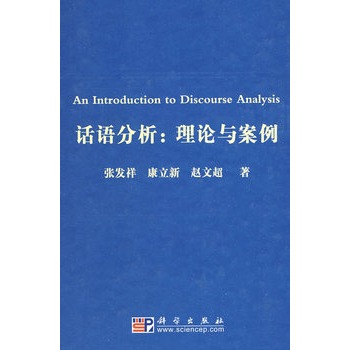基本信息
作者:張發祥, 康立新, 趙文超
出版社: 科學出版社; 第1版 (2009年4月1日)
精裝: 210頁
正文語種: 簡體中文
開本: 32
ISBN: 7030233417, 9787030233417
條形碼: 9787030233417
產品尺寸及重量: 21 x 15 x 1.4 cm ; 358 g
ASIN: B00290SQVO
內容簡介
話語分析作為一門研究語言使用的學科,在理論上“博採眾學科之精華”,在套用範圍上,話語分析的對象也可謂“包羅語言之萬象”,至今已有五十多年的發展歷史。
目錄
前言
Part One Discourse Analysis Theory
Chapter 1 An Introduction to Discourse AnaIysis
1.0 Introduction
1.1 Definition of discourse
1.2 Discourse analysis: its definition and development
1.3 “Text”, “context” and “discourse”
1.4 An understanding of DA as a discipline
1.5 Conversation analysis and conversational principles
1.5.1 Conversation analysis
1.5.2 Conversational principles
1.6 Eclecticism in discourse analysis
1.7 DA and pragmatics
Chapter 2 Methodology of Discourse Analysis
2.0 Introduction
2.1 Methods of doing discourse analysis
2.1.1 Structural discourse analysis
2.1.2 Socio-cultural discourse analysis
2.1.3 Cognitive discourse analysis
2.1.4 Critical discourse analysis
2.1.5 Integrated discourse analysis
2.2 Understanding the methods
2.2.1 In terms of focus
2.2.2 In terms of aim
2.2.3 In terms of technique
2.3 Summary
Chapter 3 Theoretical Thoughts about Discourse
3.0 Introduction
3.1 Speech act theory
3.2 Cooperative principle theory
3.3 Face and politeness principle theory
3.4 Relevance theory
3.5 The study of stylistic variation and registers
3.6 Schema theory
3.6.1 The terminology of schema theory
3.6.2 Evidence for schemata
3.6.3 The origins of schema theory
3.7 Post-structuralist theory about discourse
3.7.1 Michel Foucault's thoughts about discourse
3.7.2 M.M. Bakhtin's dialogic view on discourse
3.8 Genre theories
3.8.1 The problem of definition
3.8.2 Definitions in applied linguistics
3.8.3 Systems of genre studies
3.9 Summary
Chapter 4 Discourse Analysis and Second Language Teaching.
4.0 Introduction
4.1 Application of discourse analysis to grammar teaching
4.2 Application of discourse analysis to vocabulary teaching
4.3 Application of discourse analysis to text interpretation teaching
4.3.1 Top-down and bottom-up text processing
4.3.2 Types of text
4.3.3 Patterns in text
4.4 Application of discourse analysis to conversational interaction
teaching
4.5 Summary
Part Two Cases Analysis
Chapter 5 Discourse Types
5.0 Introduction
5.1 News discourse analysis
5.1.1 Vocabulary analysis
5.1.2 Word features
5.1.3 Syntactical analysis
5.2 Public discourse analysis
5.2.1 Modal verb analysis
5.2.2 Analysis of pronoun
5.3 Advertising discourse analysis
5.3.1 Lexical features
5.3.2 Syntactic features in advertising discourse
5.3.3 Rhetorical features in advertising discourse
5.4 Diplomatic discourse analysis
5.4.1 Forms of achieving vagueness in diplomatic discourse
5.4.2 Functions of vagueness in diplomatic discourse
5.5 Teacher-student discourse analysis
5.5.1 Elements of structure in classroom interaction
5.5.2 Classes of acts
5.5.3 Classes of moves
5.5.4 Classes of exchanges
5.6 Humorous discourse analysis
5.6.1 Remarkable characteristics of humor
5.6.2 Cooperative principle and humor
5.6.3 Speech act and humor
5.7 Network discourse analysis
5.7.1 Reasons for the formation of network discourse
5.7.2 Development of network discourse
5.7.3 Classifications of network vocabulary
5.7.4 Characteristics of network discourse
References

